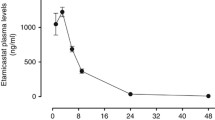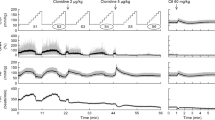Summary
Ketanserin suppresses baroreflex-mediated tachycardia following the administration of hypotensive doses of sodium nitroprusside in conscious spontaneously hypertensive rats (SHR). The purpose of this study was to compare the baroreflex effects of ketanserin with those of the more selective S2-serotonergic receptor antagonist ritanserin and the α1-blocker prazosin. In conscious SHR, both ketanserin (3 mg/kg) and prazosin (0.01 and 0.1 mg/kg) caused a significant reduction in blood pressure. Ritanserin (3 mg/kg) and the combination of a low dose of prazosin (0.01 mg/kg) and ritanserin (3 mg/kg) did not lower blood pressure significantly. Baroreflex responses were determined by measuring the maximal changes in heart period (HP = 60,000/HR) after administration of 20 to 100 µg/kg sodium nitroprusside. Whereas saline and prazosin lacked an effect on changes in HPmax, ketanserin reversed the decrease in δHPmax into a significant increase. Ritanserin alone caused a slight but insignificant inhibition, whereas the combination of ritanserin and prazosin blocked the sodium nitroprusside-induced reflex tachycardia. Ritanserin, in contrast to prazosin or ketanserin, lowered resting heart rate values. We conclude that the interference of ketanserin with the baroreflex in SHR is a unique property of this agent, related to its simultaneous effects on serotonin (5-HT) S2-receptors and α1-adrenoceptors.
Résumé
Chez le rat SHR (spontanément hypertendu) vigile, la kétansérine inhibe la tachycardie placée sous la dépendance du baroréflexe apparaissant à la suite de l’administration de doses hypotensives de nitroprussiate de sodium. Le but de la présente étude était de comparer les effets de la kétansérine sur le baroréflexe à ceux de la ritansérine, un antagoniste plus sélectif des récepteurs sérotoninergiques S2, et de la prazosine, un α1-bloquant. Chez le SHR vigile, la kétansérine (3 mg/kg) et la prazosine (0,01 et 0,1 mg/kg) ont toutes deux entraîné une diminution significative de la pression artérielle, effet non observé à la suite de l’administration d’une dose de 3 mg/kg de ritansérine, seule ou associée à la faible dose de prazosine (0,01 mg/kg). Les réponses du baroréflexe aux différents produits ont été déterminées par le calcul des modifications maximales de la période cardiaque (PC = 60.000/FC) après l’administration de 20 à 100 µg/kg de nitroprussiate de sodium. La solution saline et la prazosine n’ont eu aucun effet sur la PCmax, alors que la kétansérine a transformé la diminution du δPCmax en une augmentation significative. La ritansérine administrée seule a entraîné une légère, mais non significative, inhibition, alors que l’association ritansérine-prazosine a bloqué la tachycardie réflexe induite par le nitroprussiate. A l’inverse de la prazosine et de la kétansérine, la ritansérine a ralenti la fréquence cardiaque au repos. Cette étude permet de conclure que l’interférence de la kétansérine sur le baroréflexe chez le SHR est une propriété particulière de ce produit, liée à ses effets simultanés sur les récepteurs S2 de la sérotonine (5-HT) et sur les récepteurs α1-adrénergiques.
Zusammenfassung
Bei wachen spontanhypertensiven Ratten (SHR) supprimiert Ketanserin nach Verabfolgung blutdrucksenkender Natriumnitroprussid-Dosen die Baroreflex-vermittelte Tachykardie. Zweck dieser Studie war ein Vergleich der Baroreflexeffekte von Ketanserin mit denen des selektiver wirkenden S2-serotonergen Rezeptorantagonisten Ritanserin und des α1-Blockers Prazosin. Bei wachen SHR führte sowohl Ketanserin (3 mg/kg) als auch Prazosin (0,01 und 0,1 mg/kg) zu einer signifikanten Blutdrucksenkung. Ritanserin (3 mg/kg) und die Kombination von niedrigdosiertem Prazosin (0,01 mg/kg) und Ritanserin (3 mg/kg) senkten den Blutdruck nicht signifikant. Die Baroreflexreaktionen wurden mittels Bestimmung der maximalen Veränderungen der Herzperiode (HP = 60.000/HR) nach Applikation von 20 bis 100 µ/kg Nitroprussidnatrium ermittelt. Während Kochsalzlösung und Prazosin keine Wirkung auf die Veränderungen der HPmax zeigten, wurde die Abnahme der δHPmax durch Ketanserin in eine signifikante Zunahme verkehrt. Ritanserin allein bewirkte eine leichte, aber nicht signifikante Hemmung, während die Kombination von Ritanserin und Prazosin die durch Nitroprussidnatrium induzierte Reflextachykardie blockierte. Im Gegensatz zu Prazosin oder Ketanserin senkte Ritanserin die Herzfrequenzwerte in Ruhe. Wir folgern daraus, daß die Interferenz von Ketanserin mit dem Baroreflex bei SHR eine einzigartige Eigenschaft dieser Substanz ist, die mit ihrer gleichzeitigen Wirkung auf die Serotonin (5-HT) S2-Rezeptoren und α1-Adrenozeptoren in Zusammenhang steht.
Resumen
Ketanserin suprime la taquicardia inducida por un barorreflejo, tras la administración de dosis hipotensoras de nitroprusiato sódico, en ratas conscientes espont á neamente hipertensas (SHR). El objeto de este estudio consistía en comparar los efectos barorreflejos de ketanserin con los de ritanserin, el antagonista de receptores S2-serotonérgicos más selectivo, y el α1-bloqueador prazosin. En SHR conscientes, tanto ketanserin (3 mg/kg), como prazosin (0.01 y 0.1 mg/kg) dieron lugar a una disminución significativa de la presión sanguínea. Ritanserin (3 mg/kg) y la combinación de una baja dosis de prazosin (0.01 mg/kg) y ritanserin (3 mg/kg) no disminuyeron do modo significativo la presión sanguinea. Las respuestas barorreflejas se determinaron mediante la determinación de los cambios máximos registrados en el período cardíaco (HP) (HP = 60,000/HR) (HR = ritmo cardíaco) tras la administración de 20 a 100 µg/kg de nitroprusiato sódico. Mientras que la solución salina y prazosin no tuvieron efecto sobre cambios en el HPmax, ketanserin invirtió la disminución del δHPmax, dando lugar a un aumento significativo. Ritanserin, por sí sólo, provocó una inhibición ligera pero significativa, mientras que la combinación de ritanserin y prazosin bloqueó la taquicardia refleja inducida por el nitroprusiato sódico. En contraste con prazosin o ketanserin, ritanserin disminuyó los valores del ritmo cardíaco en reposo. Llegamos a la conclusion que la interferencia de ketanserin con el barorreflejo en SHR es una propiedad única de este fármaco, relacionada con sus efectos simult á neos sobre los S2-receptores de serotonina (5-HT) y los α1-adrenoceptores.
Similar content being viewed by others
References
Berdeaux A, Edouard S, Samii K, Giudicelli JF. Ketanserin and the arterial baroreceptor reflex in normotensive subjects. European Journal of Clinical Pharmacology 32: 27–33, 1987
Cohen ML, Fuller RW, Kurz KD. Evidence that blood pressure reduction by serotonin antagonists is related to alpha receptor blockade in spontaneously hypertensive rats. Hypertension 5: 676–681, 1983a
Cohen ML, Fuller RW, Kurz KD. LY 53857, a selective and potent serotonergic (5-HT2) receptor antagonist, does not lower blood pressure in the spontaneously hypertensive rat. Journal of Pharmacology and Experimental Therapeutics 227: 327–332, 1983b
Fozard JR. Mechanisms of the hypotensive effect of ketanserin. Journal of Cardiovascular Pharmacology 4: 829–838, 1982
Janssen PAJ. Pharmacology of potent and selective S2 serotonergic antagonists. Journal of Cardiovascular Pharmacology 7(Suppl. 7): 2–11, 1985
Kalkman HO, Timmermans PBMWM, Van Zwieten PA. Characterization of the antihypertensive properties of ketanserin in rats. Journal of Pharmacology and Experimental Therapeutics 222: 227–231, 1982
Leysen JE, Awouters F, Kennis L, Laduron PM, Vandenberk J, et al. Receptor binding profile of R 41 468, a novel antagonist at 5-HT2 receptors. Life Science 28: 1015–1022, 1981
McCall RB, Harris LT. Characterization of the central sympathoinhibitory action of ketanserin. Journal of Pharmacology and Experimental Therapeutics 241: 736–740, 1987
Petterson A, Gradin K, Hedner T, Persson B. Antihypertensive mechanism of action of ketanserin and some ketanserin analogues in the spontaneously hypertensive rat. Naunyn Schmiedeberg’s Archives of Pharmacology 329: 394–397, 1985
Ramage AG. The effects of ketanserin, methysergide and LY 53857 on sympathetic nerve activity. European Journal of Pharmacology 113: 295–303, 1985
Smits JFM, Van Essen H, Tyssen CM, Struyker Boudier HAJ. Effects of ketanserin on hemodynamics and baroreflex effects in conscious spontaneously hypertensive rats. Journal of Cardiovascular Pharmacology 10: 1–8, 1987
Vanhoutte PM, Ball SG, Berdeaux A, Cohen ML, Hedner T, et al. Mechanism of action of ketanserin in hypertension. TIPS 7: 58–61, 1986
Wenting GJ, Woittiez AJJ, Man in’t Veld AJ, Schalekamp MADH. 5-HT2, alpha-adrenoceptors, and blood pressure. Effects of ketanserin in essential hypertension and autonomic insufficiency. Hypertension 6: 100–109, 1984
Author information
Authors and Affiliations
Rights and permissions
About this article
Cite this article
Smits, J., van Dorsten, F. & Boudier, H.A.J.S. Interference of Ketanserin with Baroreflex Control of the Circulation in the Conscious Spontaneously Hypertensive Rat. Drugs 36 (Suppl 1), 55–60 (1988). https://doi.org/10.2165/00003495-198800361-00009
Published:
Issue Date:
DOI: https://doi.org/10.2165/00003495-198800361-00009




